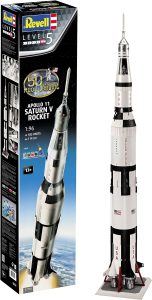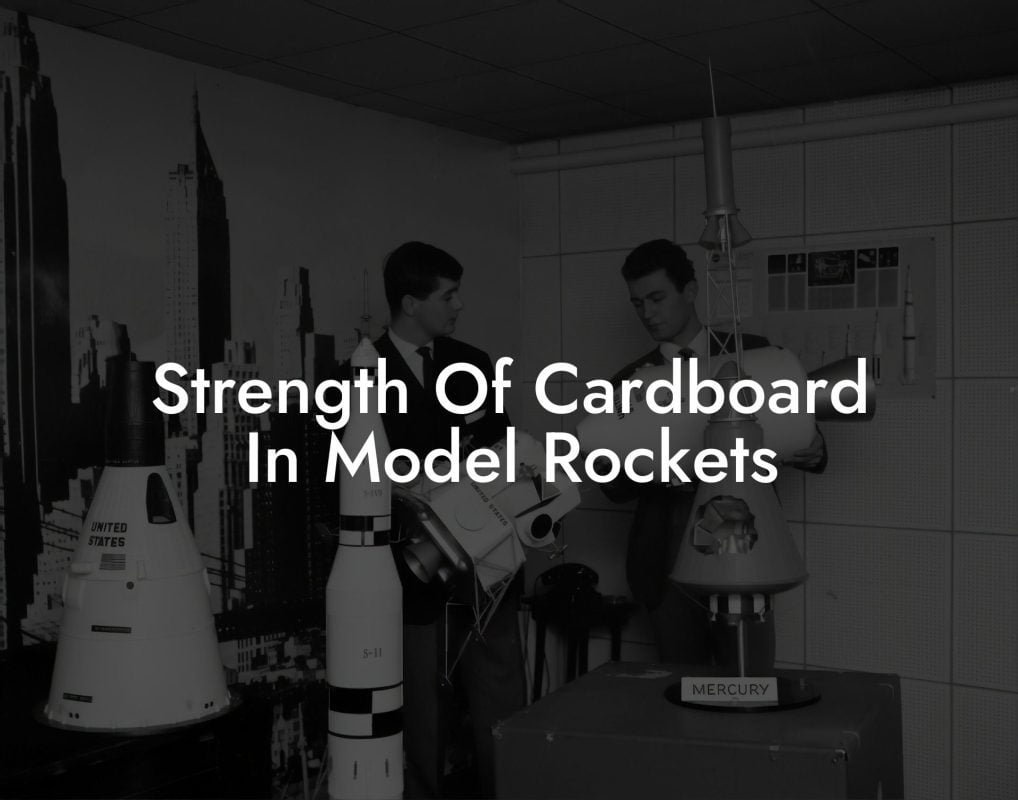Imagine soaring to new heights with a giant scale model rocket that's as impressive as it is intimidating. Welcome to the world of giant scale model rockets, where precision, power, and passion come together in a thrilling display of aerodynamics and engineering. Whether you're a seasoned model rocket enthusiast or just starting out, this comprehensive guide will blast off into the world of giant scale model rockets, exploring the what, why, and how of these incredible machines.
Quick Links to Useful Sections
- What Are Giant Scale Model Rockets?
- The Benefits of Giant Scale Model Rockets
- Designing and Building Giant Scale Model Rockets
- Materials Selection
- Aerodynamic Design
- Recovery Systems
- Flying Giant Scale Model Rockets
- Pre-Flight Preparation
- In-Flight Performance
- Post-Flight Analysis
- Giant Scale Model Rocketry Communities and Resources
- Frequently Asked Questions About Giant Scale Model Rockets
- Resources and Community Support: Your Next Steps
What Are Giant Scale Model Rockets?
Giant scale model rockets are, quite literally, the biggest and baddest of the model rocket world. With diameters ranging from 2.5 to 10 inches (6.4 to 25.4 cm) and heights reaching up to 10 feet (3 meters) or more, these massive models are designed to replicate the real thing – but on a smaller, more manageable scale. Built for performance, aesthetics, and sheer wow factor, giant scale model rockets are the ultimate expression of model rocketry.
Unlike their smaller counterparts, giant scale model rockets require a significant investment of time, money, and expertise. They demand precision engineering, advanced materials, and a deep understanding of aerodynamics, thrust vectors, and recovery systems. But for those who dare to dream big, the rewards are well worth the challenge.
The Benefits of Giant Scale Model Rockets
So, why go giant? For starters, giant scale model rockets offer an unparalleled level of realism and immersion. With their massive size and intricate details, they evoke the same sense of wonder and awe as their full-scale counterparts. But that's not all – giant scale model rockets also provide a unique opportunity to develop advanced skills, experiment with cutting-edge materials, and push the boundaries of what's possible in model rocketry.
- Unmatched realism and immersion: Giant scale model rockets are the ultimate expression of scale modeling, offering an unparalleled level of realism and detail.
- Advanced skills development: Building and flying giant scale model rockets requires advanced skills in engineering, materials science, and aerodynamics.
- Cutting-edge innovation: Giant scale model rockets provide a platform for experimenting with new materials, technologies, and techniques, driving innovation in the field.
- community engagement: Giant scale model rockets have the power to bring people together, fostering a sense of community and camaraderie among enthusiasts.
Designing and Building Giant Scale Model Rockets
Building a giant scale model rocket is a complex, multi-disciplinary endeavor that requires careful planning, precision engineering, and attention to detail. From selecting the right materials to designing and testing the recovery system, every aspect of the build process demands expertise and dedication.
Looking For The Best Model Rocket Kits? You'll Love These:
Materials Selection
Giant scale model rockets require advanced materials that can withstand the stresses of flight, including high-strength composites, precision-machined aluminum, and durable paints and finishes.
Aerodynamic Design
Aerodynamic design is critical to the success of a giant scale model rocket, with factors like drag reduction, stability, and thrust vectoring playing a crucial role in performance and safety.
Recovery Systems
A reliable recovery system is essential for giant scale model rockets, which can reach incredible altitudes and velocities. From parachutes to retro-rockets, the recovery system must be designed to safely return the rocket to Earth.
Flying Giant Scale Model Rockets
Flying a giant scale model rocket is an exhilarating experience that demands skill, focus, and attention to detail. From pre-flight checks to post-flight analysis, every aspect of the flying process requires precision and control.
Pre-Flight Preparation
Before taking to the skies, giant scale model rocket enthusiasts must conduct thorough pre-flight checks, including propellant loading, system testing, and weather evaluation.
In-Flight Performance
During flight, giant scale model rockets can reach incredible speeds and altitudes, requiring the pilot to remain focused and in control at all times.
Post-Flight Analysis
After the flight, enthusiasts can analyze performance data, review telemetry readings, and refine their designs for future improvements.
Giant Scale Model Rocketry Communities and Resources
Giant scale model rocketry is a vibrant and supportive community, with enthusiasts from around the world sharing knowledge, expertise, and passion.
- Online forums and discussion groups: Join online communities like Reddit's r/ModelRockets and r/GiantScaleModelRockets, as well as specialized forums like GiantScaleNews.com.
- Local clubs and meetups: Connect with local model rocket clubs and attend meetups to network with fellow enthusiasts and learn from their experiences.
- Industry events and competitions: Attend industry events like the annual NARAM (National Association of Rocketry Annual Meet) and participate in competitions to showcase your skills and learn from others.
- Tutorials and guides: Access online tutorials, guides, and resources like GiantScaleModelRockets.com and ModelRocketry.org to improve your skills and stay up-to-date with the latest developments.
Frequently Asked Questions About Giant Scale Model Rockets
Here are some frequently asked questions about giant scale model rockets, answered by experts in the field:
1. What's the biggest giant scale model rocket ever built?
The largest giant scale model rocket ever built is the "Vulcan," standing at an incredible 24 feet (7.3 meters) tall and weighing over 1,000 pounds (454 kg).
2. How much does it cost to build a giant scale model rocket?
The cost of building a giant scale model rocket can vary widely, depending on materials, complexity, and size, but expect to spend anywhere from $1,000 to $10,000 or more.
3. Are giant scale model rockets safe?
When built and flown responsibly, giant scale model rockets are safe, but they do pose risks if not handled properly. Always follow safety guidelines and best practices to minimize risks.
4. Can I build a giant scale model rocket as a beginner?
While giant scale model rockets are challenging, beginners can start with smaller, simpler projects and work their way up to more complex builds as they gain experience and skills.
5. What's the most challenging part of building a giant scale model rocket?
The most challenging part of building a giant scale model rocket is often the recovery system, which requires precise design and testing to ensure a safe and successful return to Earth.
Resources and Community Support: Your Next Steps
Welcome to the world of giant scale model rockets! As you embark on this incredible journey, remember that you're part of a vibrant community of enthusiasts who are passionate about pushing the boundaries of model rocketry.
Stay connected with fellow enthusiasts through online forums, local clubs, and industry events. Continuously improve your skills and knowledge by accessing tutorials, guides, and resources. And most importantly, never stop dreaming big – the sky's the limit (literally!) when it comes to giant scale model rockets.
Looking For The Best Model Rocket Kits? You'll Love These:
Useful Interruption: Dive deeper into the world of Model Rockets with our most popular sections. If there is anything you think is missing or anything you would love for us to write about, just give us a shout.
- Getting Started & Basics With Model Rockets
- Model Rocket Design, Build & Customization
- Model Rocket Propulsion & Engine Technology
- Model Rocket Launch Techniques & Recovery
- Model Rocket Advanced Rocketry & Innovations
- Model Rocket DIY and Customization
- Model Rocket Equipment Reviews & Digital Tools
- Community, Competitions & Education
- Model Rocket Troubleshooting & FAQs
- Model Rocket Bonus/Seasonal & Niche Topics
A group of model rocket enthusiasts gathered at a field for their weekly launch event. Among them was Dave, a seasoned builder known for pushing the limits of hobby rocketry. This time, he had outdone himself.
“Ladies and gentlemen,” Dave announced, dramatically pulling a cloth off his latest creation, “I present to you: The Kraken!”
The crowd gasped. This wasn’t just a model rocket, it was a monster. The thing stood 8 feet tall, had six clustered engines, and was covered in enough duct tape to qualify as a classified aerospace project.
“Dave,” muttered Steve, the cautious safety officer, “Have you, uh… done the math on this?”
“Math?” Dave scoffed. “I built it in my garage at 3 a.m. with parts from eBay. This is an art piece, Steve.”
The countdown began.
5…
4…
3…
2…
1…
The engines ignited with a BOOM, and The Kraken shot up… kind of. It immediately did a violent barrel roll, narrowly missing the spectators before skyrocketing at an angle that could only be described as “legally questionable.”
The crowd collectively ducked as The Kraken flew straight over the adjacent cornfield, where Old Man Jenkins, the grumpiest farmer in town, was minding his business.
KABOOM!
The rocket disappeared behind the barn. A moment later, a flaming piece of Estes igniter wire landed at Steve’s feet. The silence was deafening.
And then, an unmistakable sound echoed across the field.
Jenkins’ shotgun being cocked.
“DAVE!!!” Steve shouted. “RUN.”
And that was the day Dave invented the first-ever biologically powered rocket booster: pure adrenaline.
To this day, nobody knows where The Kraken landed, but legend has it, it still haunts the skies, terrifying unsuspecting drones and low-flying birds.















